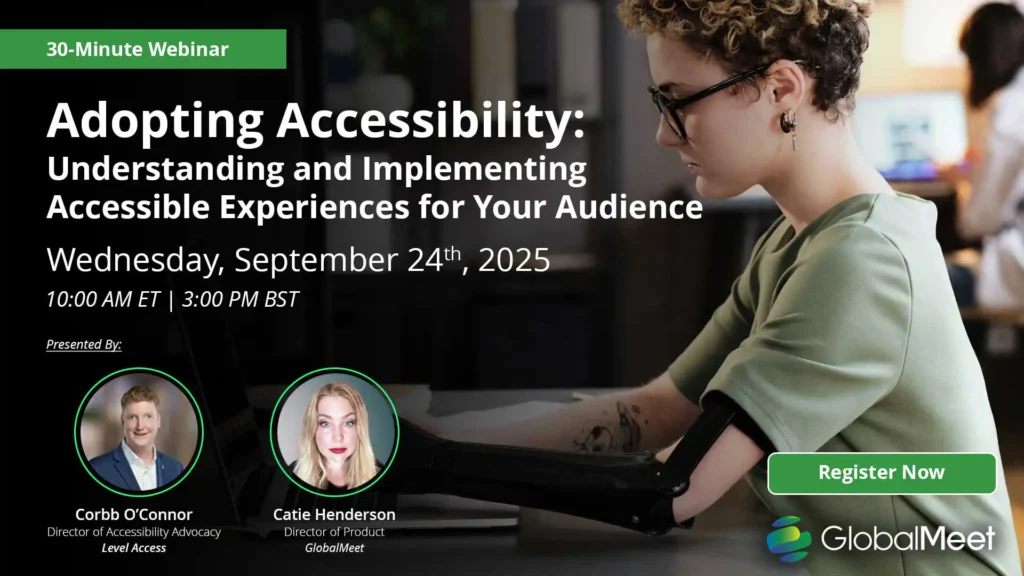
How People Learn in Virtual Environments: Cognitive Load and Information Retention
- by GlobalMeet Blog Team
- ,
In the modern world Continued Professional Development (CPD) and Continuing Professional Education (CPE) have evolved beyond traditional classroom learning. Virtual education environments now play a central role in lifelong learning and upskilling. However, despite its convenience and scope for scale, online learning also presents new difficulties for engagement, attention, and retention.
Designing sessions that have a lasting impact requires an understanding of how people learn in virtual environments. Cognitive Load Theory (CLT) which studies how information is processed and stored in working memory, is fundamental in this field. Event planners can utilize CLT principles to create CPE programs that increase comprehension, reduce mental fatigue, and boost knowledge retention.
Virtual Learning: Passive vs Active
The distinction between passive and active learning is important in any learning environment, however it is considerably more noticeable in virtual setting.
Typically, passive learning entails listening to a lecture or watching a presentation without participating, and though this can be useful for rapid communication of information it can also result in superficial understanding and poor retention. This is an even greater risk in virtual settings where distractions come more frequently.
Active learning, on the other hand, requires engagement and participation. This could involve participating in surveys and polls, contributing to discussion topics, or using scenarios and case studies to demonstrate knowledge. Active learning makes content more memorable, and helps CPE participants form stronger cognitive connections long term.
To design more active learning experiences for CPE consider:
- Using breakout rooms for group discussions
- Incorporated quizzes and polls
- Embedding reaction prompts at regular intervals
- Create knowledge checkpoint tests for each topic
These elements not only reduce passivity, but also distribute the cognitive load across different areas of the brain, increasing processing depth and retention.
Enhancing Virtual Presentations to Reduce Cognitive Overload
The amount of mental effort required to process and understand information is called Cognitive Load. Multitasking, screen weariness, and unfamiliar or poorly designed interfaces all increase the danger of Overload in virtual environments.
CLT notes three distinct types of cognitive load:
- Intrinsic Load: The material’s inherent difficulty to learn
- Extraneous Load: How the information is delivered
- Germane Load: The work needed to internalize knowledge
An efficient, CLT based CPE design aims to maximize Germane Load while minimizing Extraneous Load. By structuring your virtual content around CLT principles, you can create a space where learners are more likely to stay engaged, and learn effectively.
Keep Slides Simple
In the simplest sense, this means avoiding clutter on your slides. It is better to use only one key idea per slide, lay it out clearly, and eliminate any unnecessary visuals or text. This allows participants to focus on the core message without having to sift through additional information.
Consider Your Pace
When delivering CPE it’s important to slow down and avoid rushing through information just for the sake of getting it finished. Utilizing pauses, repetition, and breaks to allow for Q&A might feel counterproductive when considering session length, but it will allow learners to better understand and internalize the concepts being presented.
Limit Session Length
Best practice suggests that CPE sessions should be no longer than 60-90 minutes, with regular breaks included. But many learners may benefit from sessions that are far shorter, with content split into microlearning segments for increased flexibility and retention.
Use Consistent Interfaces
Switching platforms or formats through the course of a session can increase cognitive friction, especially if the learners are also expected to switch. Wherever possible it is better to keep to the same unified platform, and only move to an alternative tool when integration is not available.
Provide Pre-Session Materials
Providing content in advance allows learners to familiarize themselves with the key concepts that each session is going to cover. This not only gives them the opportunity to research on their own, but also reduces some of the intrinsic load during the session itself.
Improving Retention with Repetition, Visuals, and Spaced Learning
Even the most well-designed learning session fails if the information presented isn’t retained. This is especially relevant in cases where learning must be applied in practical, real-world contexts following the session. Research shows that repetition, visual aids, and spaced learning can work alongside CLT structures to significantly boost learner retention, delivering better ROI for both individuals and organizations.
Repetition
Repetition reinforces neural pathways and helps encode information into long-term memory. However, rather than repeating content verbatim it is better to reintroduce key concepts in different contexts.
Maximize repetition by:
- Using a quiz at the end of a session to revisit earlier topics
- Summarizing key takeaways at regular intervals
- Inviting learners to explain concepts in their own words
Using Visuals
Most people, even those who are not visual learners, can have their virtual learning enhanced by visual aids. Using visuals such as diagrams, flowcharts, and infographics can reduce cognitive load by presenting complicated topics in a more digestible format.
When using visuals, remember:
- Visual aids should always clarify and enhance information
- Diagrams and images should compliment taught content
- Try to avoid using distracting animations or transitions
Spaced Learning
Rather than trying to cover an entire curriculum in a single session, it is often better to spread CPE over multiple weeks. Evidence suggests that spacing out learning sessions can improve retention by leveraging the psychological spacing effect and allowing for increased repetition over time.
When planning your CPE:
- Consider shorter, weekly sessions instead of long formats
- Test learning with activities and quizzes at regular intervals
- Make use of post-session emails to reinforce key information
Tools to Support Learning Outcomes in Virtual CPE Sessions
Choosing the right digital tools and platforms can make or break a virtual learning experience. When used well they can support attention, interaction, and comprehension, but the wrong software can damage outcomes for even the most skilled educators.
When choosing the right CPE platform for your business, it’s vital to ensure that everything you need can be provided in one place, with integrations to support learning outcomes.
Alongside engagement and interactivity tools, the best platforms should have:
- High audio and video quality so that your message isn’t lost to poor connection
- Enterprise level security features to ensure that your learners’ data is protected
- Compliance features such as certification and record keeping
- Analytics integration so you can see how your learners are performing
- Captioning and translation tools so nobody’s excluded
With an approach founded in science, and the right platform supporting your CPE needs, you can create sessions that not only inform, but inspire.
Conclusion
Virtual learning isn’t just a digital version of the classroom; it’s a fundamentally different environment that requires rethinking how we teach and learn. For CPD and CPE programs to truly succeed, they must adapt and account for how the brain works in an online space.
By distinguishing between passive and active learning, managing cognitive load, and reinforcing information through repetition, visuals, and spaced learning, facilitators can greatly improve outcomes. When supported with the right tools, virtual CPE becomes more than a checkbox exercise, it becomes an opportunity for genuine growth and professional transformation.



